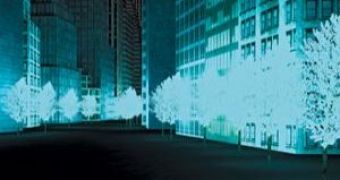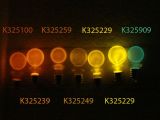A team of undergraduates at the University of Cambridge, observed the living beings than glow naturally in the dark and developed genetic tools that allow bioluminescence features to be transferred into an organism.
So in a few years, you could walk the streets at night and your path could be lit by bioluminescent trees, glowing a spectral blue.
Fireflies and the marine bacteria Vibrio fischeri have a natural ability of glowing in the dark, but their light is too weak, so the researchers, who took part in the annual International Genetically Engineered Machines competition (iGEM), modified their genetic material to stimulate the production and activity of light-yielding enzymes.
Once this was achieved, they managed to create genetic components – 'BioBricks', that can be introduced into a genome.
They introduced these genes into Escherichia coli bacterium and obtained a range of colors, and they also found that in order to have enough light to read, a volume of bacterial culture almost the size of a regular wine bottle was necessary.
The problem with bioluminescence is that this process is based on luciferins – a class of compounds that emit light and are then converted into oxyluciferin – compounds than no longer emit light.
So the Cambridge team had to engineer BioBricks that would make organisms produce enzymes that recycled oxyluciferin, NewScientist reports.
Theo Sanderson, a geneticist part of the team, explained that they “didn't end up making bioluminescent trees, which was the inspiration for the project.
“But we decided to make a set of parts that would allow future researchers to use bioluminescence more effectively.”
Alexandra Daisy Ginsberg, a designer and artist who advised the Cambridge team, said that it's unlikely that glowing trees will someday replace street lighting, because “we already have light bulbs.
“We're not going to spend our money and time engineering a replacement for something that works very well.”
However, there are many people that could benefit from growing bioluminescent plants, especially those whose homes are not wired up to the electricity grid.
There seem to be no flaws to the bioluminescent plants: they cannot break, and if you need more light, you simply grow more of them.
Ginsberg added that 'bio-light' could be a very special thing, because “there's something much more visceral about a living light.
“If you have to feed the light and look after it, then it becomes more precious.”
For the sake of their first idea, the team calculated that in order for a bioluminescent tree to replace street light, it would have to divert only 0.02% of the energy absorbed for photosynthesis, into light production.
The findings were presented earlier this month at the iGEM Jamboree, held at the Massachusetts Institute of Technology.
Watch a preview of Project Firefly:

 14 DAY TRIAL //
14 DAY TRIAL // 
